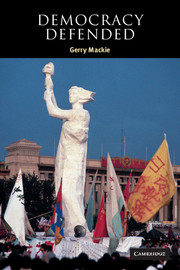Book contents
- Frontmatter
- Contents
- List of figures
- List of tables
- Acknowledgments
- 1 A long, dark shadow over democratic politics
- 2 The doctrine of democratic irrationalism
- 3 Is democratic voting inaccurate?
- 4 The Arrow general possibility theorem
- 5 Is democracy meaningless? Arrow's condition of unrestricted domain
- 6 Is democracy meaningless? Arrow's condition of the independence of irrelevant alternatives
- 7 Strategic voting and agenda control
- 8 Multidimensional chaos
- 9 Assuming irrational actors: the Powell amendment
- 10 Assuming irrational actors: the Depew amendment
- 11 Unmanipulating the manipulation: the Wilmot Proviso
- 12 Unmanipulating the manipulation: the election of Lincoln
- 13 Antebellum politics concluded
- 14 More of Riker's cycles debunked
- 15 Other cycles debunked
- 16 New dimensions
- 17 Plebiscitarianism against democracy
- 18 Democracy resplendent
- Endnotes
- References
- Index
12 - Unmanipulating the manipulation: the election of Lincoln
Published online by Cambridge University Press: 22 September 2009
- Frontmatter
- Contents
- List of figures
- List of tables
- Acknowledgments
- 1 A long, dark shadow over democratic politics
- 2 The doctrine of democratic irrationalism
- 3 Is democratic voting inaccurate?
- 4 The Arrow general possibility theorem
- 5 Is democracy meaningless? Arrow's condition of unrestricted domain
- 6 Is democracy meaningless? Arrow's condition of the independence of irrelevant alternatives
- 7 Strategic voting and agenda control
- 8 Multidimensional chaos
- 9 Assuming irrational actors: the Powell amendment
- 10 Assuming irrational actors: the Depew amendment
- 11 Unmanipulating the manipulation: the Wilmot Proviso
- 12 Unmanipulating the manipulation: the election of Lincoln
- 13 Antebellum politics concluded
- 14 More of Riker's cycles debunked
- 15 Other cycles debunked
- 16 New dimensions
- 17 Plebiscitarianism against democracy
- 18 Democracy resplendent
- Endnotes
- References
- Index
Summary
Introduction
By way of background, Riker's overarching hypothesis is that the slavery dimension of concern was suppressed by the Democratic Party manipulative elite with the Missouri Compromise of 1820. The main dimension of contention between the Democrats and the Whigs, both bisectional parties, was economic, broadly speaking the Democratic coalition was agrarian, and the Whig coalition was commercial in orientation. Another manipulative elite, the northern wing of the Whigs, the weaker party in this period, sought to find an issue that would split the Democrats and thereby allow the northern Whigs to organize a newly dominant coalition. The Wilmot Proviso in 1846 was their first effort to contrive a cycle, and the election of Lincoln in 1860 was their last and most successful effort at contriving a cycle. There is much that is wrong about this story, but that is for the next chapter.
In this chapter we first examine Riker's analysis of the 1860 presidential election. Riker estimates the preferences among the population over the four candidates. These estimates show both that there was a cycle among the top three candidates and that different hypothetical voting rules would yield different outcomes. This is the perfect illustration of Riker's contentions that democracy is meaningless and arbitrary and that manipulation is probable on grand issues. I relate the histories and the ideologies of the four parties in the runup to the 1860 election.
- Type
- Chapter
- Information
- Democracy Defended , pp. 258 - 280Publisher: Cambridge University PressPrint publication year: 2003



